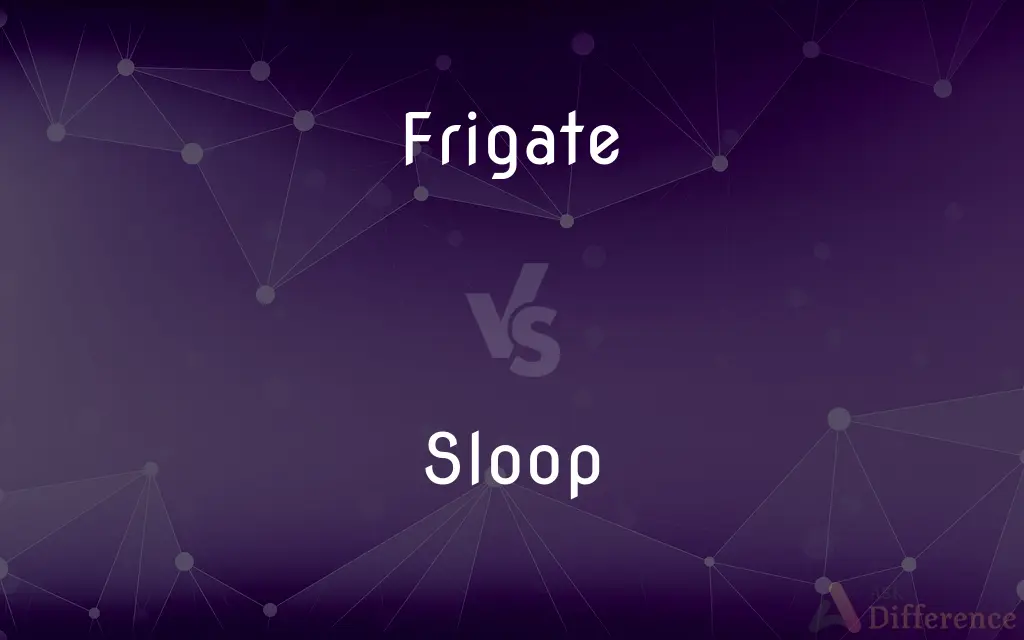Frigate vs. Sloop — What's the Difference?
By Maham Liaqat & Fiza Rafique — Updated on March 29, 2024
Frigates are warships with mixed armament, designed for speed and maneuverability, while sloops are smaller, single-masted sailing vessels, often used for patrol or escort duties.

Difference Between Frigate and Sloop
Table of Contents
ADVERTISEMENT
Key Differences
Frigates, historically, were medium-sized ships of the fleet, known for their speed and agility, often deployed for escort missions, reconnaissance, and showing the flag. They were built to be fast enough to evade heavier ships while being capable of engaging smaller vessels. Frigates typically carried and used in the age of sail through the early 19th century, evolving into more heavily armed ships in modern navies. On the other hand, sloops were smaller ships, either single-masted or with a fore-and-aft rig, used for various purposes including war, trade, and exploration. In a naval context, sloops of war were often smaller than frigates and served as escorts, patrol ships, or in other supportive roles. They were agile and could navigate in waters where larger ships could not.
Frigates were usually commanded by a post-captain in the age of sail, indicating their importance and size in a naval hierarchy. They played a crucial role in naval operations, capable of independent action, which was vital for tasks such as raiding, blockade, and protection of merchant vessels. Sloops, on the other hand, were typically commanded by commanders or lieutenant commanders, reflecting their smaller size and the scope of their missions. Sloops could often operate closer to shorelines and perform tasks such as surveying, message carrying, and support of larger ships.
In terms of armament, frigates were heavily armed, designed to deliver a broadside in naval battles. Their firepower was significant but balanced with the need for speed and maneuverability. Sloops, however, were lightly armed, primarily intended for self-defense or minor offensive actions. This difference in armament reflected the varied roles these ships played within a navy, with frigates taking on more combative missions and sloops focusing on reconnaissance, escort, and patrol duties.
Regarding their role in naval strategy, frigates were often at the forefront of naval engagements, using their speed to chase down enemies or evade superior forces. They were versatile ships that could be used across a range of missions, from fleet actions to solitary cruises. Sloops, while not typically at the center of naval battles, were indispensable for the maintenance of control over vast stretches of ocean, protecting convoys, and undertaking exploration and mapping tasks. Their smaller size and versatility made them suitable for a variety of roles that supported larger fleet operations.
Frigates and sloops both played pivotal roles in naval history, but their functions and characteristics varied significantly. Frigates were seen as the workhorses of the fleet, capable of undertaking a wide range of tasks with a balance of speed, firepower, and range. Sloops, though smaller and less heavily armed, were crucial for the detailed and specific missions that required agility and the ability to operate in shallower waters or closer to coastlines.
ADVERTISEMENT
Comparison Chart
Size
Medium, carrying more crew
Smaller, with fewer crew
Role
Escort, reconnaissance, naval battles
Patrol, escort, reconnaissance, and support roles
Armament
Heavily armed for combat
Lightly armed for defense and minor engagements
Command
Often commanded by a post-captain
Typically commanded by commanders or lieutenant commanders
Operational Use
Independent action in a wide range of naval missions
Supportive role, operating closer to shore and in support of larger ships
Compare with Definitions
Frigate
In modern navies, a frigate is a fast, long-endurance ship, often tasked with escort duties.
The navy deployed a frigate to escort the merchant convoy through the pirate-infested waters.
Sloop
A single-masted sailing vessel, typically with a fore-and-aft rig.
The sloop sailed smoothly across the bay, its single sail catching the wind.
Frigate
Frigates are equipped with a variety of armaments, including cannons and missiles.
The frigate's missiles were armed and ready for the command to fire.
Sloop
Sloops are versatile, used historically for trade, war, and exploration.
The explorer set sail in a sturdy sloop, charting unknown territories.
Frigate
A warship of intermediate size, designed for speed and maneuverability.
The frigate swiftly maneuvered into combat position.
Sloop
In naval terms, a sloop-of-war was a small warship, lighter than a frigate.
The sloop-of-war was dispatched to patrol the coast for enemy ships.
Frigate
Used for patrol, escort, and warfare, bridging the gap between smaller patrol ships and larger destroyers.
The frigate patrolled the disputed waters, maintaining a vigilant watch.
Sloop
Modern sloops serve various purposes, including training and recreational sailing.
The naval academy's sloop served as a training vessel for cadets.
Frigate
Historically, a sailing warship with a single continuous gun deck.
The frigate's gun deck was ready for action as the enemy approached.
Sloop
Known for their agility and ability to navigate shallow waters.
The sloop navigated the shallow river, avoiding sandbanks and obstacles.
Frigate
A frigate () is a type of warship. In different eras, ships classified as frigates have had very varied roles and capabilities.
Sloop
A sloop is a sailboat with a single mast typically having only one headsail in front of the mast and one mainsail aft of (behind) the mast. Such an arrangement is called a fore-and-aft rig, and can be rigged as a Bermuda rig with triangular sails fore and aft, or as a gaff-rig with triangular foresail(s) and a gaff rigged mainsail.
Frigate
A warship that is smaller than a destroyer and used primarily for escort duty.
Sloop
A single-masted, fore-and-aft-rigged sailing boat with a short standing bowsprit or none at all and a single headsail set from the forestay.
Frigate
A high-speed, medium-sized sailing war vessel of the 1600s, 1700s, and 1800s.
Sloop
(nautical) A single-masted sailboat with only one headsail.
Frigate
(Obsolete) A fast, light vessel, such as a sailboat.
Sloop
(military) A sloop-of-war, smaller than a frigate, larger than a corvette.
Frigate
(nautical) Any of several types of warship:
Sloop
A vessel having one mast and fore-and-aft rig, consisting of a boom-and-gaff mainsail, jibs, staysail, and gaff topsail. The typical sloop has a fixed bowsprit, topmast, and standing rigging, while those of a cutter are capable of being readily shifted. The sloop usually carries a centerboard, and depends for stability upon breadth of beam rather than depth of keel. The two types have rapidly approximated since 1880. One radical distinction is that a sloop may carry a centerboard. See Cutter, and Illustration in Appendix.
Frigate
(historical) A sailing warship (of any size) built for speed and maneuverability; typically without raised upperworks, having a flush forecastle and tumblehome sides.
Sloop
In modern usage, a sailing vessel having one mast, commonly with a Bermuda rig, with either a center-board or a keel. In the United States, a sloop may have one or two headsails, while in Western Europe and Great Britain a sloop has only one headsail.
Frigate
(historical) A warship combining sail and steam propulsion, typically of ironclad timber construction, supplementing and superseding sailing ships of the line at the beginning of the development of the ironclad battleship.
Sloop
A sailing vessel with a single mast set about one third of the boat's length aft of the bow
Frigate
(historical) A escort warship, smaller than a destroyer, introduced in World War 2 as an anti-submarine vessel.
Frigate
A modern type of warship, equivalent in size or smaller than a destroyer, often focused on anti-submarine warfare, but sometimes general purpose.
Frigate
(fictional) A warship or space warship, inspired by one of the many historic varieties of frigate.
Frigate
Any small vessel on the water.
Frigate
A medium size square-rigged warship of the 18th and 19th centuries
Frigate
A United States warship larger than a destroyer and smaller than a cruiser
Common Curiosities
Can sloops engage in combat like frigates?
Sloops can engage in combat but are generally less equipped for large-scale battles compared to frigates, which carry more firepower.
How did the role of frigates evolve over time?
Frigates evolved from fast, agile ships of the age of sail to modern warships designed for a variety of tasks, including escort duties and anti-submarine warfare.
Can modern sloops be considered warships?
Modern sloops are not typically classified as warships; they serve more often in training, research, or recreational roles.
Did frigates participate in fleet battles?
Yes, frigates participated in fleet battles, using their speed to outmaneuver opponents and provide strategic advantages.
What is the main difference between a frigate and a sloop?
A frigate is a larger, more heavily armed warship designed for speed and maneuverability, while a sloop is smaller, lighter, and often used for patrol, escort, and reconnaissance duties.
What kind of missions do sloops perform today?
Today, sloops are mainly used for training, recreational sailing, and sometimes for research or patrol duties in specific contexts.
Why were sloops favored for exploration?
Sloops were favored for exploration due to their smaller size, agility, and the ability to navigate through shallow and narrow waters.
Are frigates still used in modern navies?
Yes, frigates are still used in modern navies, often for escort duties, anti-submarine warfare, and showing the flag.
Were sloops used in exploration?
Yes, sloops were used for exploration due to their agility and ability to navigate in shallow waters.
What is the significance of a sloop's single mast?
The single mast of a sloop simplifies its rigging and handling, making it more agile and easier to navigate, especially in tight or shallow waters.
How are frigates and sloops different in terms of armament?
Frigates are heavily armed with a broad range of weaponry for combat, while sloops have lighter armaments primarily for defense and minor offensive actions.
How does the command structure differ between frigates and sloops?
Frigates are typically commanded by higher-ranking officers like post-captains, reflecting their larger size and broader mission scope, while sloops are commanded by commanders or lieutenant commanders.
What made frigates important in naval history?
Frigates were important for their versatility, capable of performing a wide range of naval tasks from escorting convoys to engaging in naval battles.
Did the armament of frigates change over time?
Yes, the armament of frigates has evolved significantly, from primarily cannons in the age of sail to a combination of missiles, and other modern weaponry.
How do sloops contribute to naval operations today?
While not primary warships, sloops contribute to naval operations through training, patrol, and sometimes support roles, benefiting from their agility and versatility.
Share Your Discovery

Previous Comparison
Wagon vs. Car
Next Comparison
Sugarcane vs. BambooAuthor Spotlight
Written by
Maham LiaqatCo-written by
Fiza RafiqueFiza Rafique is a skilled content writer at AskDifference.com, where she meticulously refines and enhances written pieces. Drawing from her vast editorial expertise, Fiza ensures clarity, accuracy, and precision in every article. Passionate about language, she continually seeks to elevate the quality of content for readers worldwide.
















































